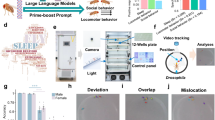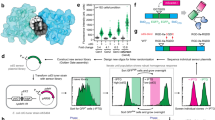Abstract
Several transient receptor potential channels were recently found to be activated by temperature stimuli in vitro1,2,3,4,5,6,7,8,9,10,11,12,13,14. Their physiological and behavioral roles are largely unknown. From a temperature-preference behavior screen of 27,000 Drosophila melanogaster P-insertion mutants, we isolated a gene, named pyrexia (pyx), encoding a new transient receptor potential channel. Pyx was opened by temperatures above 40 °C in Xenopus laevis oocytes and HEK293T cells. It was ubiquitously expressed along the dendrites of a subset of peripheral nervous system neurons and was more permeable to K+ than to Na+. Although some pyx alleles resulted in abnormal temperature preferences, pyx null flies did not have significantly different temperature preferences than wild-type flies. But 60% of pyx null flies were paralyzed within 3 min of exposure to 40 °C, whereas only 9% of wild-type flies were paralyzed by the same stimulus. From these findings, we propose that the primary in vivo role of Pyx is to protect flies from high-temperature stress.
This is a preview of subscription content, access via your institution
Access options
Subscribe to this journal
Receive 12 print issues and online access
$209.00 per year
only $17.42 per issue
Buy this article
- Purchase on Springer Link
- Instant access to full article PDF
Prices may be subject to local taxes which are calculated during checkout




Similar content being viewed by others
References
Story, G.M. et al. ANKTM1, a TRP-like channel expressed in nociceptive neurons, is activated by cold temperatures. Cell 112, 819–829 (2003).
Peier, A.M. et al. A TRP channel that senses cold stimuli and menthol. Cell 108, 705–715 (2002).
McKemy, D.D., Neuhausser, W.M. & Julius, D. Identification of a cold receptor reveals a general role for TRP channels in thermosensation. Nature 416, 52–58 (2002).
Viswanath, V. et al. Opposite thermosensor in fruitfly and mouse. Nature 423, 822–823 (2003).
Watanabe, H. et al. Heat-evoked activation of TRPV4 channels in a HEK293 cell expression system and in native mouse aorta endothelial cells. J. Biol. Chem. 277, 47044–47051 (2002).
Guler, A.D. et al. Heat-evoked activation of the ion channel, TRPV4. J. Neurosci. 22, 6408–6814 (2002).
Peier, A.M. et al. A heat-sensitive TRP channel expressed in keratinocytes. Science 296, 2046–2049 (2002).
Smith, G.D. et al. TRPV3 is a temperature-sensitive vanilloid receptor-like protein. Nature 418, 186–190 (2002).
Xu, H. et al. TRPV3 is a calcium-permeable temperature-sensitive cation channel. Nature 418, 181–186 (2002).
Caterina, M.J. et al. The capsaicin receptor: a heat-activated ion channel in the pain pathway. Nature 389, 816–824 (1997).
Caterina, M.J., Rosen, T.A., Tominaga, M., Brake, A.J. & Julius, D. A capsaicin-receptor homologue with a high threshold for noxious heat. Nature 398, 436–441 (1999).
Tracey, W.D., Wilson, R.I., Laurent, G. & Benzer, S. painless, a Drosophila gene essential for nociception. Cell 113, 261–273 (2003).
Caterina, M.J. et al. Impaired nociception and pain sensation in mice lacking the capsaicin receptor. Science 288, 306–313 (2000).
Davis, J.B. et al. Vanilloid receptor-1 is essential for inflammatory thermal hyperalgesia. Nature 405, 183–187 (2000).
Sayeed, O. & Benzer, S. Behavioral genetics of thermosensation and hygrosensation in Drosophila. Proc. Natl Acad. Sci. USA 93, 6079–6084 (1996).
Gilchrist, G.W. & Huey, R.B. The direct response of Drosophila melanogaster to selection on knockdown temperature. Heredity 83, 15–29 (1999).
Liu, L., Yermolaieva, O., Johnson, W.A., Abboud, F.M. & Welsh, M.J. Identification and function of thermosensory neurons in Drosophila larvae. Nat. Neurosci. 6, 267–273 (2003).
Gao, F.B., Brenman, J.E., Jan, L.Y. & Jan, Y.N. Genes regulating dendritic outgrowth, branching, and routing in Drosophila. Genes Dev. 13, 2549–2561 (1999).
Heiinrich, B. The Hot-Blooded Insects: Strategies and Mechanisms of Thermoregulation (Harvard University Press, Cambridge, Massachusetts, 1993).
Lee, Y. β-Amyloid peptide binding protein does not couple to G protein in heterologous Xenopus expression system. J. Neurosci. Res. 73, 255–259 (2003).
Kim, J. et al. Integration of positional signals and regulation of wing formation and identity by Drosophila vestigial gene. Nature 382, 133–138 (1996).
Acknowledgements
We thank D. Stafford for help in preparation of this manuscript, J.J. Park for help in statistical analysis and Y. Jan for the GAL4109(2)80(md-GAL4);UAS-mCD8GFP fly stock. This research has been supported by grants from Brain Research Center of the 21st Century Frontier Program, Korea Science and Engineering Foundation, NRL and Biodiscovery program funded by the Ministry of Science and Technology of Korea.
Author information
Authors and Affiliations
Corresponding author
Ethics declarations
Competing interests
The authors declare no competing financial interests.
Supplementary information
Supplementary Fig. 1
Temperature-preference assay apparatus. (PDF 221 kb)
Supplementary Fig. 2
I-V plot of ion substitution experiments. (PDF 324 kb)
Rights and permissions
About this article
Cite this article
Lee, Y., Lee, Y., Lee, J. et al. Pyrexia is a new thermal transient receptor potential channel endowing tolerance to high temperatures in Drosophila melanogaster. Nat Genet 37, 305–310 (2005). https://doi.org/10.1038/ng1513
Received:
Accepted:
Published:
Issue Date:
DOI: https://doi.org/10.1038/ng1513



